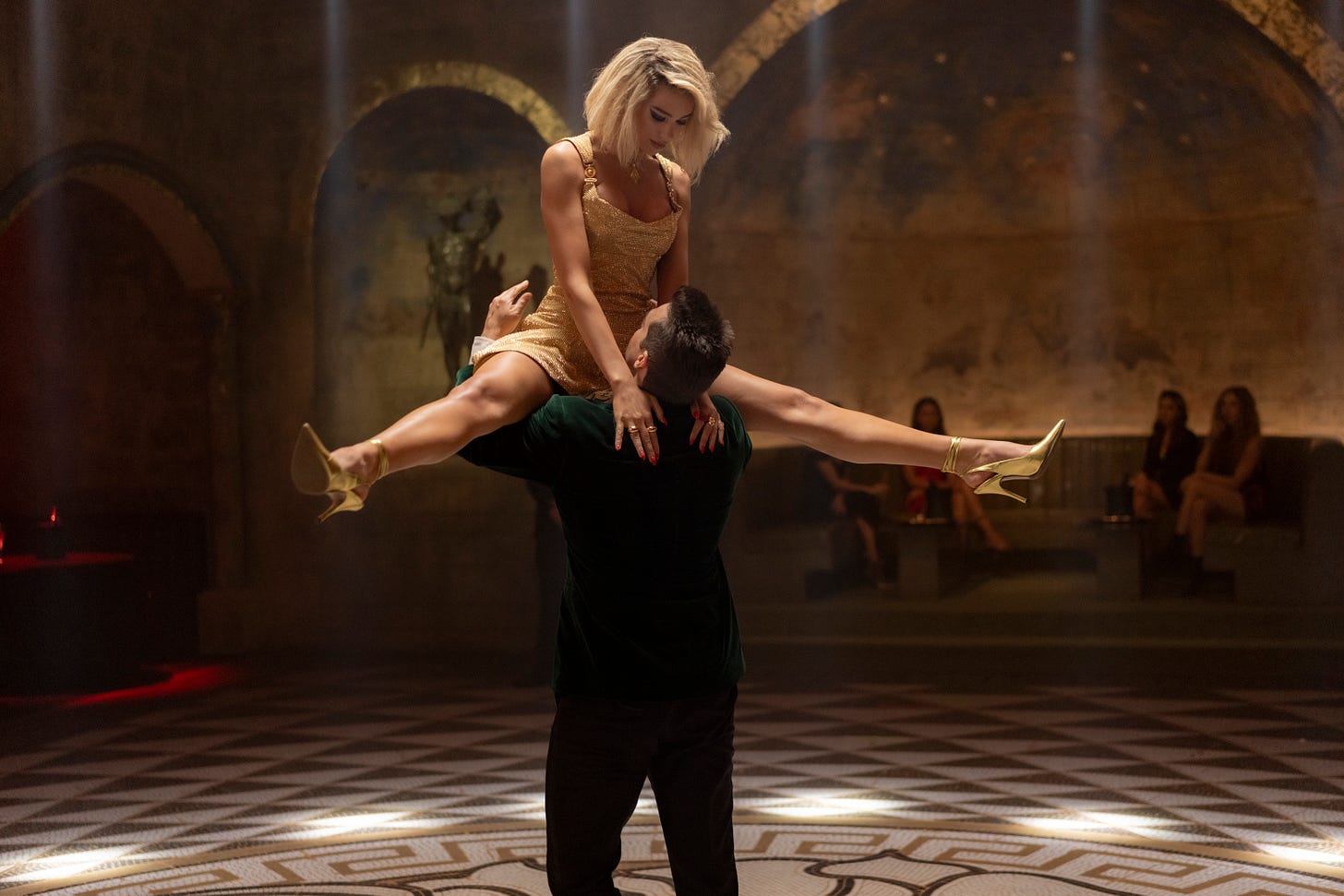MATTHEW VAUGHN STACKS THE LAYERS of metafiction as high as he can in Argylle, a spy-action-comedy that’s a book within a movie within another series of movies, maybe. Possibly.
The plot is both simple and aggressively convoluted: Elly Conway (Bryce Dallas Howard) is the author of the series of Argylle spy novels, which she constructs in her mind’s eye with Henry Cavill playing the role of superspy Argylle and John Cena as his trusty partner, Wyatt. According to Aidan Wilde (Sam Rockwell)—who stops a series of assassins from taking Elly out while she travels by train to see her mother, Ruth (Catherine O’Hara)—Elly’s books have made her a target because they seem to be predicting the future. Everything she writes comes true. So she needs to keep writing to solve the mystery of a missing data file that will expose a secret agency that’s up to no good, etc.
If you’ve seen the trailer—and if you’ve been to the theater in the last six months, it’s been hard to miss—I’ve given nothing away here; I won’t deprive you of the twists and turns if you plan on sitting through the 130-some minutes of story.
As a spy movie, Argylle is faintly derivative—the MacGuffin is a variety of ‘NOC list’ of the sort we’ve seen in dozens of movies since Tom Cruise’s initial Mission: Impossible; the characters lie to each other (and, therefore, the viewer) as a matter of course—and one gets the sense that Vaughn and writer Jason Fuchs understand just how derivative this is by peppering the book-within-a-movie with the most generic, mealy-mouthed dialogue possible. It’s a bit predictable and a little silly.
As a comedy, though, that silliness is welcome and it bounces well off of Rockwell’s fantastic comic timing. Honestly, I’m kind of surprised it’s taken so long to get him into this sort of wisecracking, action-oriented sort of role; I guess it’s a function of the Marvel Cinematic Universe having used him so early, as a villain in Iron Man 2. Howard is perfectly cast as the mousey novelist, though she’s not entirely believable when she’s called upon to take more direct action later on in the picture. Bryan Cranston, who plays the menacing head of a spy agency, has never forgotten his beginning in Seinfeld and Malcolm in the Middle, but he also channels a bit of Walter White here. It’s the most I’ve liked him in a film in quite some time.
As an action movie, Argylle feels firmly within Vaughn’s comfort zone. The set pieces will be familiar to anyone who enjoys his Kingsman series insofar as they create a simulacrum of fluidity without actually being fluid. The sequence on the train feels very much like the final fight in Poppy’s Diner in Kingsman: The Golden Circle, and there’s a big, psychedelically colored shootout at the end of this film that owes a debt to the exploding head symphony in the first Kingsman. Given the appearance of Statesman bourbon1 on a couple of different desks in Argylle and a mid-credits scene teasing a forthcoming Argylle: Book One: The Movie that takes place in a pub with a very familiar name, these similarities may well be intentional.
Argylle is also very much a product of its time on the action movie front. What I mean is: almost nothing looks like it takes place in anything resembling a real location. It’s a common problem in so many movies these days, one that’s especially pronounced in the bigger-budget Netflix pictures. Red Notice is perhaps the most glaring example of this—the bullfighting sequence and the prison breakout were two of the most egregiously green-screened sequences I think I’ve ever seen—though I imagine seeing Rebel Moon on a big screen rather than my TV at home might have taken the cake.
Argylle suffers from this same disease. There’s an identifiable fakeness to the green-screen work here—rooftops that are clearly surrounded by nothing but blue walls; oceans that contain nary a drop of water; even an oil slick used in an action sequence that makes it obvious that nothing on the screen is an actual, physical item—that audiences are going to look back on in five, ten, twenty years from now and say “Oh yeah, that’s a streaming-era picture.” It’s the inability to match light sources and shadows, the way the buildings in the background are either out of focus or in too-clear focus, the uncanny valley of a skyline that’s too brilliantly blue, a sun too perfectly flared on the horizon. It’d be one thing if, say, Vaughn had chosen to use the completely fake backgrounds solely in the book-within-the-movie, the flatness of the Hong Kong skyline complementing the shallowness of Elly’s writing. But by bringing it into the “real” world as well, you realize it’s just … well, laziness is the only word. It looks terrible, but it’s quicker to shoot, so Hey, let’s give it a shot!
You expect a certain amount of corner-cutting with lower-budgeted stuff; recently I was watching The Bricklayer, a bad new VOD action movie from director Renny Harlin, and I was struck by how transparently terrible the green-screen work was there. But that’s a movie made on the cheap as quickly as possible. Argylle, Red Notice, Rebel Moon, and other, similar titles are nine-figure productions backed by enormous studios with top-tier talent in front of and behind the camera. Use some of that money to go to real places. The shoddiness is glaring, almost galling; it makes you pine for the days and designs of Michael Bay, who actually takes cameras to real places and shoots real people with real explosions. The sooner we exit this era of big-budget action filmmaking, the better.
You can actually buy the Statesman bourbon from Old Forrester. I highly recommend it; it’s extremely tasty and available at a relatively decent price point of $40–$50, depending on your preferred liquor purveyor.





